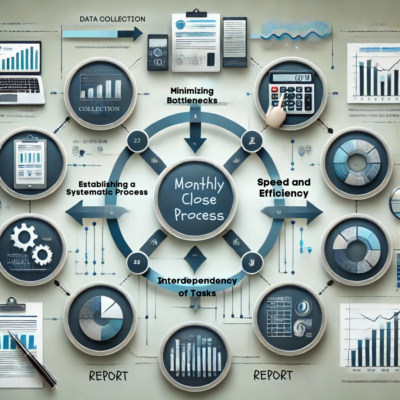Monthly Close Process – Week #27 of The Financial Operating System®

One of the most important pieces of the Process leg of the Finance Stack is the monthly close process. This week we focus on this key procedure that ensures accurate and timely financial reporting. Chapter 14 describes the methodical set of tasks required to close the books each month and provides actionable steps to streamline this process.
What is the Monthly Close Process?
- A series of repetitive monthly tasks aimed at producing accurate financial reports.
- Key activities include:
-
Reconciliation: Bank and credit card account and other account reconciliations.
-
Analysis: Reviewing revenue and expense accounts for accuracy.
-
Adjustments: Making accrual entries for revenue and expense recognition.
-
Reporting: Producing accurately and useful reports for management and owners
-
Key Components of a Good Monthly Close Process
-
Establishing a Systematic Process:
- Create and adhere to a structured monthly close checklist.
- Ensure the checklist covers all critical accounting tasks beyond simple reconciliations.
-
Speed and Efficiency:
- Strive to complete the monthly close as quickly as possible without sacrificing accuracy.
- Aim to deliver financial performance reports by the 15th-20th of the following month, which is a reasonable target for small businesses, especially those that outsource accounting or utilize part-time employees.
-
Interdependency of Tasks:
- Recognize that some tasks depend on the completion of others. For instance:
- Posting customer and vendor payments must precede account reconciliations.
- Revenue and expense adjustments often require earlier reports to be finalized before adjustments can be determined.
- Recognize that some tasks depend on the completion of others. For instance:
-
Minimizing Bottlenecks:
- Complete as many tasks as possible during the prior month (e.g., payroll postings and flagging fixed assets or prepaid expenses).
- Reserve only essential tasks for post-month-end processing that cannot be completed during the month.
Options for Timely Information During the Month
- Although full financial reports are important, critical data points are available during the month or very shortly after the end of the month before full financial reports are available
- Use weekly scorecards to track key metrics and reduce reliance on end-of-month reporting.
- Focus on identifying monthly revenue shortly after the month’s end, as it is often the most significant driver of financial results.
Benefits of a Well-Executed Monthly Close
- Timely access to accurate financial data empowers managers to make informed decisions promptly.
- Reduces the likelihood of errors from incomplete or inconsistent accounting.
Additional Insights
- Implementing accrual accounting enhances the reliability of financial reports. While small businesses may not need full GAAP compliance, adopting basic accrual standards ensures that revenues and expenses are recognized in the appropriate periods.
- Efficient practices, such as using a Management Accrual Standard, can achieve most of GAAP’s benefits without excessive complexity.
Next Step:
Business owners can self-implement The Financial Operating System. Chapters are available to download at smartbooks.com/resources or you can buy the whole book from Amazon (the marketing firm version or the general business version).
If you would like assistance with implementation or would like to accelerate results for your business, please contact author Cal Wilder at cwilder@smartbooks.com or book a free consultation with our team directly using this calendar link.